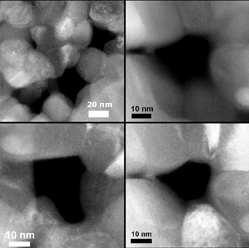Crossref Citations
This article has been cited by the following publications. This list is generated based on data provided by
Crossref.
Wu, Longjia
Dey, Sanchita
Gong, Mingming
Liu, Feng
and
Castro, Ricardo H. R.
2014.
Surface Segregation on Manganese Doped Ceria Nanoparticles and Relationship with Nanostability.
The Journal of Physical Chemistry C,
Vol. 118,
Issue. 51,
p.
30187.
Chang, Chi-Hsiu
Gong, Mingming
Dey, Sanchita
Liu, Feng
and
Castro, Ricardo H. R.
2015.
Thermodynamic Stability of SnO2Nanoparticles: The Role of Interface Energies and Dopants.
The Journal of Physical Chemistry C,
Vol. 119,
Issue. 11,
p.
6389.
Miagava, Joice
da Silva, Andre L.
Navrotsky, Alexandra
Castro, Ricardo H.R.
Gouvêa, Douglas
and
Rohrer, G.
2016.
The Nanocrystalline SnO2–TiO2 System‒Part II: Surface Energies and Thermodynamic Stability.
Journal of the American Ceramic Society,
Vol. 99,
Issue. 2,
p.
638.
Hasan, Md M.
Dey, Sanchita
Nafsin, Nazia
Mardinly, John
Dholabhai, Pratik P.
Uberuaga, Blas P.
and
Castro, Ricardo H. R.
2016.
Improving the Thermodynamic Stability of Aluminate Spinel Nanoparticles with Rare Earths.
Chemistry of Materials,
Vol. 28,
Issue. 14,
p.
5163.
Castro, Ricardo H. R.
Gouvêa, Douglas
and
Wakai, F.
2016.
Sintering and Nanostability: The Thermodynamic Perspective.
Journal of the American Ceramic Society,
Vol. 99,
Issue. 4,
p.
1105.
Filipovic, Lado
and
Selberherr, Siegfried
2016.
Stress Considerations for System-on-Chip Gas Sensor Integration in CMOS Technology.
IEEE Transactions on Device and Materials Reliability,
Vol. 16,
Issue. 4,
p.
483.
Wang, Xin
Ren, Pengrong
Tian, Hailin
Fan, Huiqing
Cai, Changlong
and
Liu, Weiguo
2016.
Enhanced gas sensing properties of SnO2: The role of the oxygen defects induced by quenching.
Journal of Alloys and Compounds,
Vol. 669,
Issue. ,
p.
29.
Pereira, Gilberto J.
Bolis, Karen
Muche, Dereck N.F.
Gouvêa, Douglas
and
Castro, Ricardo H.R.
2017.
Direct measurement of interface energies of magnesium aluminate spinel and a brief sintering analysis.
Journal of the European Ceramic Society,
Vol. 37,
Issue. 13,
p.
4051.
Wu, Longjia
Dholabhai, Pratik P.
Uberuaga, Blas P.
and
Castro, Ricardo H. R.
2017.
Temperature Dependence Discontinuity in the Stability of Manganese-Doped Ceria Nanocrystals.
Crystal Growth & Design,
Vol. 17,
Issue. 2,
p.
446.
Li, Hui
Dey, Sanchita
and
Castro, Ricardo H.R.
2018.
Kinetics and thermodynamics of densification and grain growth: Insights from lanthanum doped zirconia.
Acta Materialia,
Vol. 150,
Issue. ,
p.
394.
Li, Hui
Souza, Flavio L.
and
Castro, Ricardo H.R.
2018.
Kinetic and thermodynamic effects of manganese as a densification aid in yttria-stabilized zirconia.
Journal of the European Ceramic Society,
Vol. 38,
Issue. 4,
p.
1750.
da Silva, Andre L.
Muche, Dereck N. F.
Caliman, Lorena B.
Bettini, Jefferson
Castro, Ricardo H. R.
Navrotsky, Alexandra
and
Gouvêa, Douglas
2019.
TiO2 Surface Engineering to Improve Nanostability: The Role of Interface Segregation.
The Journal of Physical Chemistry C,
Vol. 123,
Issue. 8,
p.
4949.
Leitner, Jindřich
and
Sedmidubský, David
2019.
Thermodynamic Modeling of Oxidation of Tin Nanoparticles.
Journal of Phase Equilibria and Diffusion,
Vol. 40,
Issue. 1,
p.
10.
Yang, Chenguang
Zhu, Weidi
Sen, Sabyasachi
and
Castro, Ricardo H. R.
2019.
Site Inversion Induces Thermodynamic Stability against Coarsening in Zinc Aluminate Spinel.
The Journal of Physical Chemistry C,
Vol. 123,
Issue. 14,
p.
8818.
Sharma, Geetu
Nakajima, Kimiko
Muche, Dereck N.F.
and
Castro, Ricardo H.R.
2020.
The influence of dopants on the surface enthalpy of Yttrium aluminum garnet (YAG).
Thermochimica Acta,
Vol. 683,
Issue. ,
p.
178471.
Shelyug, Anna
and
Navrotsky, Alexandra
2021.
Thermodynamics of Fluorite-Structured Oxides Relevant to Nuclear Energy: A Review.
ACS Earth and Space Chemistry,
Vol. 5,
Issue. 3,
p.
703.
Bah, Micka
Podor, Renaud
Retoux, Richard
Delorme, Fabian
Nadaud, Kevin
Giovannelli, Fabien
Monot‐Laffez, Isabelle
and
Ayral, André
2022.
Real‐Time Capturing of Microscale Events Controlling the Sintering of Lead‐Free Piezoelectric Potassium‐Sodium Niobate.
Small,
Vol. 18,
Issue. 18,
Kumar, Aniket
Mathur, Lakshya
Bae, Hohan
Sim, U.K.
and
Song, Sun-Ju
2022.
Design of Novel transition metal based multiphase stannate: An efficient electrocatalyst for oxygen evolution reaction.
Materials Chemistry and Physics,
Vol. 279,
Issue. ,
p.
125613.



